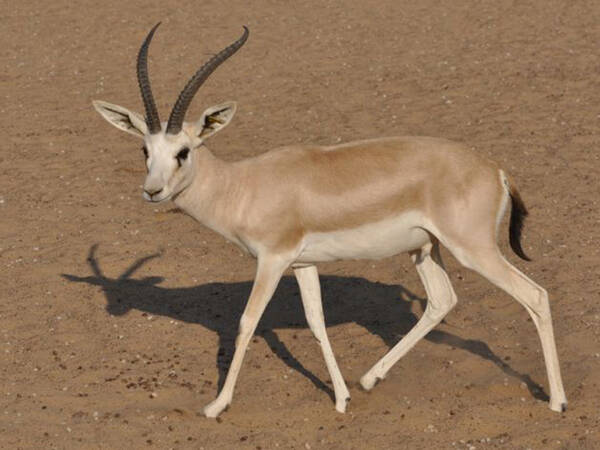Gazella marica
IUCN
LCBasic Information
Scientific classification
- name:Gazella marica
- Scientific Name:Gazella marica,Sand Gazelle
- Outline:Ungulata
- Family:Artiodactyla Bovidae Gazelle
Vital signs
- length:About 82 cm
- Weight:18-22kg
- lifetime:No verification information
Feature
Distribution and Habitat
Distributed in Iraq, Jordan, Kuwait, Oman, Qatar, Saudi Arabia, Syrian Arab Republic, United Arab Emirates, and Yemen.
Reintroduced: Turkey.
Origin uncertain: Bahrain.
The Arabian gazelle lives in deserts, semi-deserts, hilly and mountainous areas, and coastal plains. The gazelle on Farasan Island, Saudi Arabia, inhabits broken coral gullies and flat gravelly areas.
Appearance
The Arabian sand gazelle is 97 cm long (including a 15 cm long tail); about 55-60 cm tall. Males weigh about 22 kg and females weigh 18 kg. Both males and females have horns, which are up to 27 cm long for males and 15 cm long for females. They are small in size. They have slender legs and are good at jumping and running.
Strong physique; with legs suitable for long-distance running; there are 4 toes on the feet, but the lateral toes are more degenerate than those of deer, which are suitable for running; the incisors and canines are degenerate, but the lower incisors are retained, and the lower canines are incisorized, with three pairs of incisors tilted forward and shovel-shaped. Because they feed on relatively hard plants, the premolars and molars have high crowns, the enamel is wrinkled, and the surface forms complex tooth patterns after the crowns are worn, which is suitable for eating grass; the stomach has 4 chambers, and the rumination function is complete; both adult males a
Details
Arabian Sand Gazelle (Scientific name: Gazella marica) English: Arabian Sand Gazelle, Arabic: Reem, no subspecies. The Arabian Sand Gazelle was previously classified as a subspecies of the Goitered Gazelle. DNA evidence shows that although the two species are closely related, they represent different lineages, so the Arabian Sand Gazelle is considered a separate species. In 2012, biologists such as Hassanin found that the pairwise distance between the Gully's Gazelle, the Slender-horned Gazelle and the Arabian Sand Gazelle was very low (<1.5%), and suggested that the Slender-horned Gazelle and the Arabian Sand Gazelle be considered subspecies of the Gully's Gazelle. This will have a significant impact on conservation efforts, and it is urgent to further clarify this situation and do more research on their relationships.

The Arabian Sand Gazelle is usually seen at night, feeds mainly on Cyperus rotundus, and obtains moisture mainly from dew.
The total population of the Arabian Sand Gazelle in 2008 was estimated to be less than 12,000. Oman: estimated in the late 1990s at around 13,000, including 10,000 in Jiddat al Harasis Saudi Arabia 1,500-1,700, of which 1,000 are in the Farasan Islands and more than half in Farasan Kebir; no estimates are available for Yemen, but it is generally described as rare here.

Oman has the largest population of the Arabian sand gazelle species, which has been heavily poached for several years and is suspected to have significantly reduced in numbers. As of 2015, the total population was estimated to be well below 10,000 mature individuals. The remaining "Arabian gazelles" (considered by some as a separate subspecies of Arabian gazelle) have declined from 50 in 2012 to about 12 in 2013, and most are kept in fenced reserves to protect them. The main threats facing the species are illegal hunting for meat and live capture for pets and private collections. Overgrazing is a factor in many parts of the region.
Listed in the IUCN Red List of Threatened Species in 2016 ver3.1 - Vulnerable (VU).
Protect wildlife and eliminate bushmeat.
Maintaining ecological balance is everyone's responsibility!








